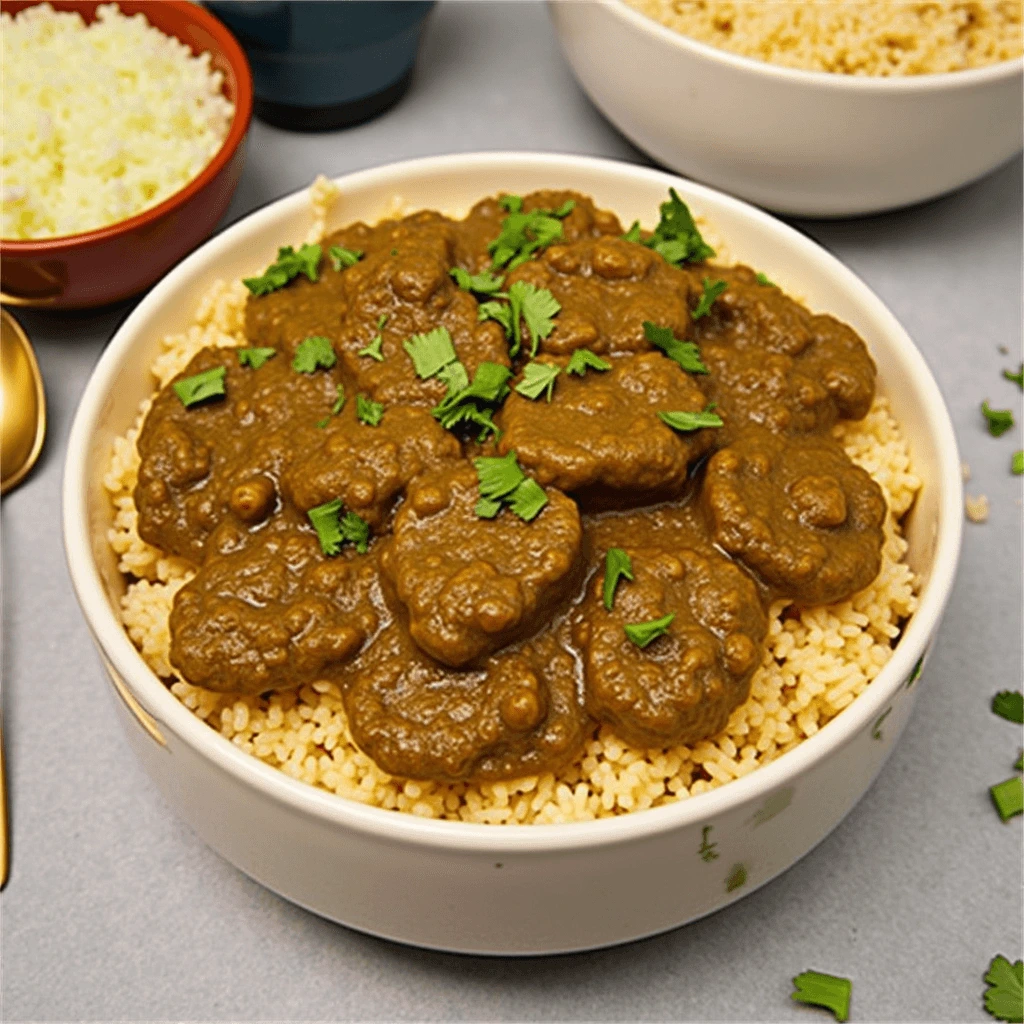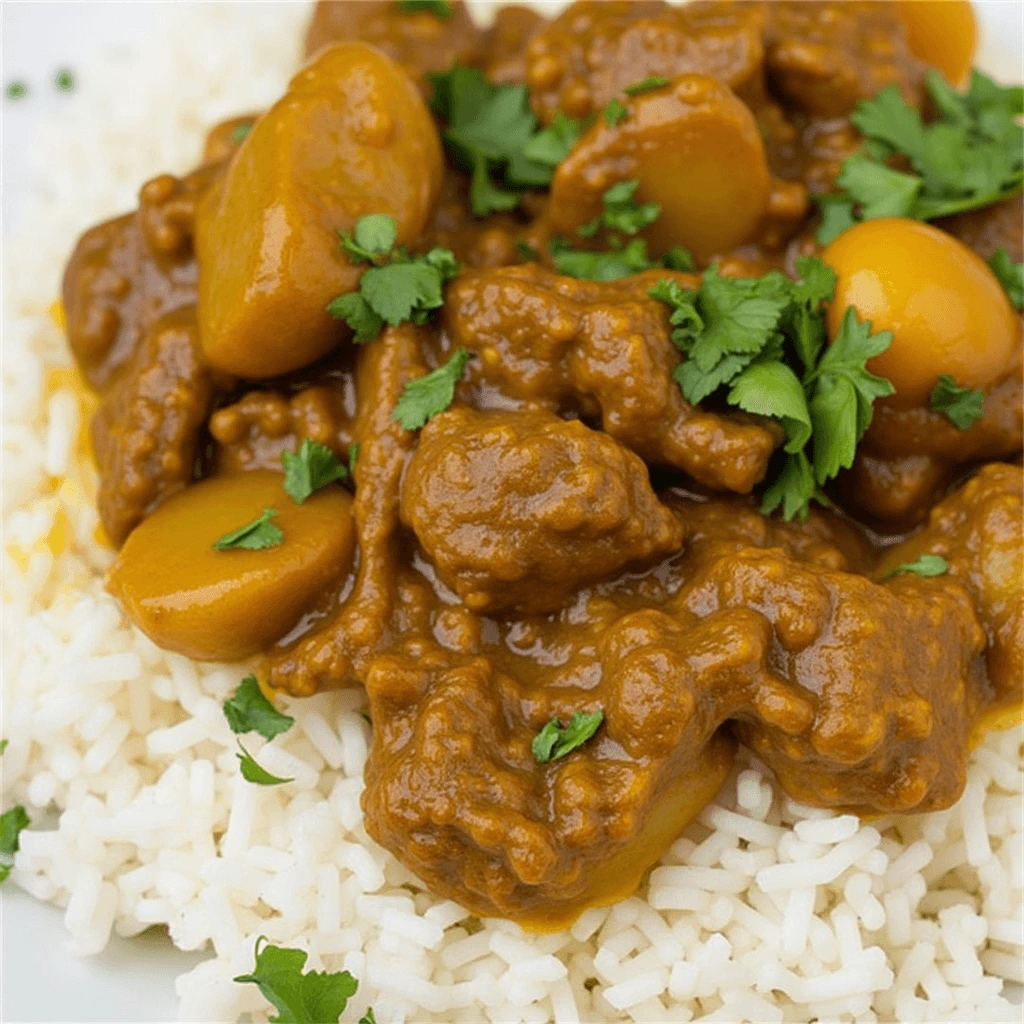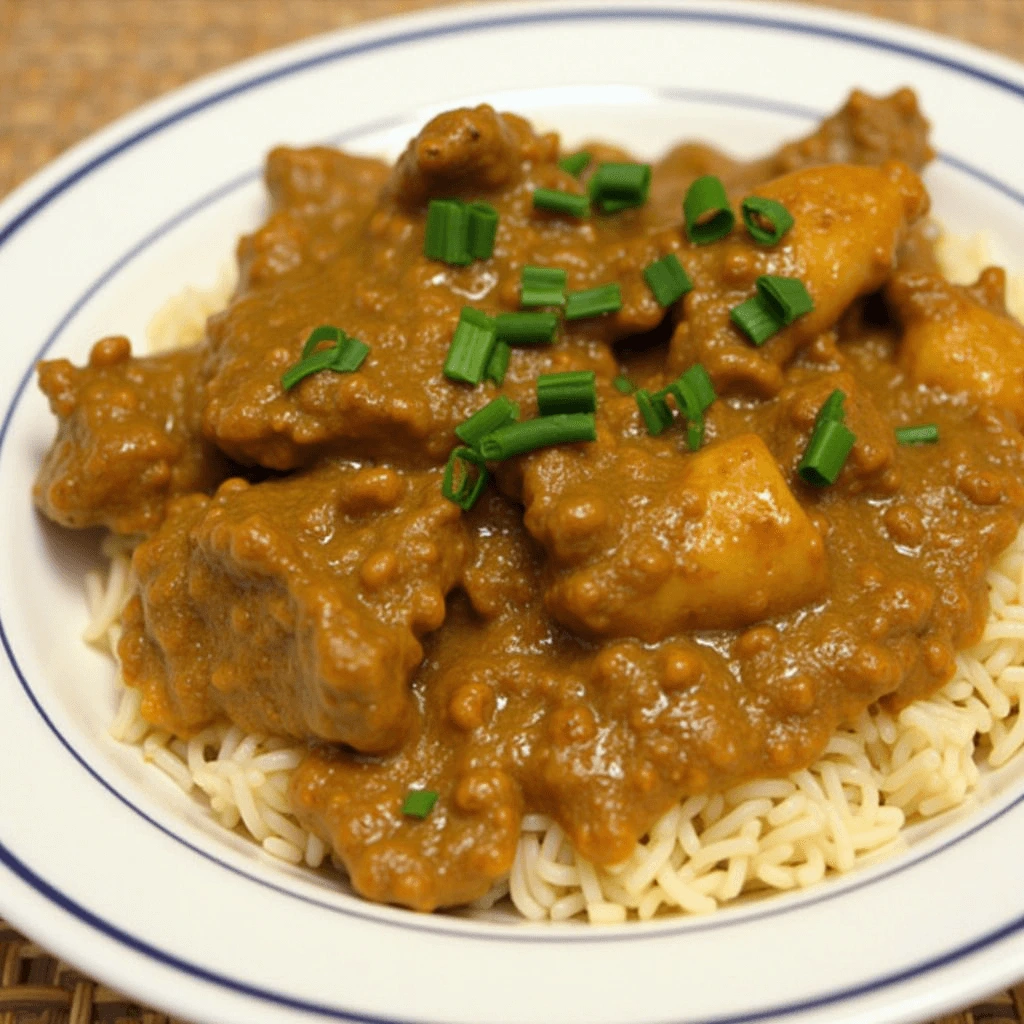Beef Curry Recipe: Why It’s the Ultimate Comfort Food Dish
Beef Curry Recipe is the ultimate comfort food because of its deep, layered flavors. The slow-cooked beef absorbs the aromatic spices, resulting in a dish that is both bold and comforting. The combination of garlic, ginger, and garam masala creates a mouthwatering aroma that fills your kitchen as it cooks. The sauce, whether coconut-based or tomato-based, thickens into a rich, velvety texture that coats every bite, making it incredibly satisfying.
Table of Contents
Perfect for Cold Evenings or Cozy Meals
There’s nothing better than a warm bowl of beef curry on a chilly evening. The blend of warming spices like turmeric, cumin, and cinnamon helps create a dish that is not only flavorful but also soothing. Whether you’re having a solo meal, a family dinner, or a gathering with friends, beef curry brings comfort and nostalgia with every bite. Pair it with fluffy basmati rice or naan for the ultimate cozy meal.
A Dish with Global Influence: Indian, Thai, and More
Beef curry is loved worldwide, with each culture putting its own spin on the dish. In Indian cuisine, beef curry is slow-cooked with bold spices, tomatoes, and yogurt for a deep, rich taste. Thai beef curry often features coconut milk, lemongrass, and fresh herbs, giving it a slightly sweet and fragrant profile. Japanese beef curry has a mild and slightly sweet flavor, often thickened with curry roux and served with rice. The versatility of beef curry makes it a dish that can be enjoyed in different ways, depending on personal preference and regional influences.
Key Ingredients for the Best Beef Curry
Choosing the Right Beef: Tender Cuts for Curry

The choice of beef cut plays a crucial role in the overall texture and flavor of your curry. For a tender, melt-in-your-mouth experience, braising cuts like chuck roast, short ribs, or brisket are perfect. These cuts contain connective tissue that breaks down slowly when cooked, infusing the curry with rich flavor and creating a tender bite. While ground beef can be used for quicker, weeknight curries, slow-cooked beef is ideal for achieving the deep, rich flavor that makes beef curry so comforting.
For the best results, consider marinating the beef in a mixture of yogurt and spices before cooking. This not only tenderizes the meat but also infuses it with flavor from the inside out, making each bite flavorful and juicy.
Beef Curry Recipe Table
| Ingredient | Quantity |
|---|---|
| Beef stew meat (cubed) | 1.5 lbs (700g) |
| Onion (chopped) | 1 large |
| Garlic (minced) | 3 cloves |
| Fresh ginger (grated) | 1 tbsp |
| Use 2 medium tomatoes (diced or pureed) | 1 cup of canned tomatoes. |
| Coconut milk | 1 cup (240 ml) |
| Curry powder | 2 tbsp |
| Garam masala | 1 tsp |
| Ground cumin | 1 tsp |
| Ground coriander | 1 tsp |
| Red chili powder | ½ tsp (optional for heat) |
| Salt | To taste |
| Black pepper | ½ tsp |
| Oil (vegetable or ghee) | 2 tbsp |
| Water or beef broth | ½ cup (as needed) |
| Fresh cilantro (for garnish) | A handful, chopped |
Cooking Steps
| Step | Instructions |
|---|---|
| 1 | Warm oil in a pot and cook the onions until they turn golden brown. |
| 2 | Add garlic and ginger; cook for 1 minute. |
| 3 | Stir in all spices; cook until fragrant. |
| 4 | Add beef; brown on all sides. |
| 5 | Mix in tomatoes; cook until soft or thickened. |
| 6 | Pour in coconut milk and broth; stir well. |
| 7 | Simmer covered for 1.5–2 hours, until beef is tender. |
| 8 | Uncover and simmer for 10 minutes to thicken. |
| 9 | Garnish with fresh cilantro and serve with rice or naan. |
Essential Spices: Curry Powder, Garam Masala & More
The heart of any great beef curry is the blend of spices used. Curry powder is a staple, providing a balanced base of warmth and complexity, but it’s the addition of other spices that truly elevates the dish. Garam masala, a fragrant Indian spice blend, includes cinnamon, cardamom, and cloves, creating a depth of flavor that complements the richness of the beef.
Other essential spices include turmeric for its earthy flavor and vibrant color, cumin for its warm, nutty taste, and coriander for a hint of citrusy freshness. Fenugreek is often used in Indian-style curries to add a slightly bitter note, which balances the richness of the dish. These spices can be toasted in oil at the beginning of cooking to release their essential oils and create an aromatic base for the curry.
Additionally, chili powder or fresh chilies can be added to adjust the level of heat, making the dish as spicy as you like. Whether you prefer a mild curry or one that packs a punch, the spice blend is customizable to suit your taste.
Coconut Milk vs. Tomato-Based Curry: Which is Better?
One of the most important decisions when making beef curry is whether to use coconut milk or a tomato-based sauce as the base. Both options bring something unique to the dish.
- Coconut milk lends a creamy, slightly sweet flavor that complements the spices and beef. It’s commonly used in Thai-style beef curry and gives the dish a velvety texture, perfect for a comforting meal. Coconut milk also helps to tone down the heat if you like a spicier curry.
- Tomato-based curries are typically more tangy and slightly acidic, providing a sharp contrast to the richness of the beef. This option is frequently used in Indian-style beef curries, where the tomatoes are cooked down into a thick, flavorful sauce. The acidity of the tomatoes balances the rich spices and meat, creating a bright and savory profile.
Both types of curry offer their own unique appeal, and choosing between coconut milk and tomatoes depends on the flavor profile you prefer for your curry.
Step-by-Step Guide to Making Homemade Beef Curry
Marinating the Beef for Maximum Flavor
Soaking the beef in a marinade prior to cooking helps enhance its flavor and ensures a tender texture. A simple marinade can include yogurt, garlic, ginger, and spices like turmeric, cumin, and garam masala. The yogurt’s acidity breaks down the fibers in the beef, making it more tender while the spices penetrate the meat.
Marinate the beef for 30 minutes to overnight. A longer marination time intensifies the flavors, but even a quick soak will produce a delicious result.
Choosing the Right Cooking Method: Slow Cooker vs. Instant Pot
There are two popular methods for cooking Beef Curry Recipe: slow cooking and the Instant Pot. Both create tender beef and a flavorful curry, but each method has distinct benefits.
- Slow Cooking: Ideal if you have several hours to spare. Slow cooking allows the beef to break down, absorbing the spices and creating a rich, deep-flavored curry. This method is perfect for making meals ahead of time.
- Instant Pot: A faster option, the Instant Pot uses pressure to cook the beef in under an hour while still producing tender results. It’s the go-to choice when you’re short on time but still want a flavorful curry.
Both methods work well, but slow cooking creates a more traditional, rich flavor, while the Instant Pot is great for convenience.
Creating a Thick and Flavorful Curry Sauce
The sauce is the soul of a great Beef Curry Recipe. Here’s how to ensure your curry sauce is thick and packed with flavor:
- Sauté Aromatics: Start by sautéing onions, garlic, and ginger in oil until golden brown. This builds the flavor base for the curry.
- Cook the Spices: Add your spices and cook them in the oil for a few minutes. This step releases their oils, enhancing their flavors.
- Thicken the Sauce: To thicken the sauce, consider adding ground almonds or a cornstarch slurry (cornstarch mixed with water). Alternatively, simmer the curry uncovered to reduce the liquid and naturally thicken it. If using coconut milk, the creaminess will help thicken the sauce as it cooks.
- Simmer for Depth: Let the curry simmer gently to allow the beef to tenderize and the flavors to develop. This step is key to achieving a flavorful, well-rounded curry sauce.
Best Ways to Serve Beef Curry

Pairing with Rice: Basmati, Jasmine, or Brown Rice
One of the best ways to serve Beef Curry Recipe is with a hearty serving of rice. The rice not only complements the richness of the curry but also helps balance the spices, creating a harmonious meal. Here are some rice options that work wonderfully with beef curry:
- Basmati Rice: This long-grain rice is a classic pairing with Indian-style Beef Curry Recipe. Its light, fluffy texture and aromatic flavor make it perfect for soaking up the rich sauce of the curry. The delicate fragrance of basmati enhances the curry without overpowering it.
- Jasmine Rice: If you’re making a Thai-style beef curry, jasmine rice is the ideal choice. This fragrant rice is slightly sticky, which helps it hold up well against the curry’s creamy texture. The subtle floral aroma of jasmine rice adds another layer of fragrance to the dish.
- Brown Rice: For a healthier option, brown rice offers a nuttier flavor and chewier texture. It’s a great alternative if you’re looking to add more fiber to your meal. The earthiness of brown rice pairs well with the rich, flavorful beef curry.
All of these rice varieties are excellent choices depending on your curry style and personal preference. The goal is to choose rice that can absorb the curry sauce, so it becomes part of the overall experience.
Traditional Sides: Naan, Roti, or Chapati
In addition to rice, traditional flatbreads are another fantastic way to serve beef curry. These breads are perfect for dipping into the curry sauce, making each bite more satisfying. Here are a few options:
- Naan: This soft, pillowy flatbread is a popular choice for soaking up beef curry. It’s often made with yogurt, which gives it a slight tang and a rich, fluffy texture. Naan can be served plain or with garlic, cheese, or even herbs for extra flavor.
- Roti: A more rustic flatbread made with whole wheat flour, roti is less rich than naan but still an excellent choice. It’s thinner and slightly firmer, but it’s still great for scooping up curry.
- Chapati: Similar to roti but often slightly thinner and more delicate, chapati is a versatile bread that pairs well with any curry. It’s traditionally served with Indian dishes and is a healthier alternative to naan because it’s typically made without oil or butter.
Serving beef curry with one or more of these breads adds texture and allows you to enjoy the sauce in a different way. You can also toast the breads lightly to add a crisp contrast to the rich, creamy curry.
Garnishes that Enhance the Flavor: Cilantro, Yogurt & More
Garnishing your Beef Curry Recipe can elevate the dish by adding freshness and extra layers of flavor. Here are a few garnish options that enhance the curry:
- Fresh Cilantro: A sprinkle of fresh cilantro adds a burst of color and a refreshing, herbal note that contrasts nicely with the deep spices of the curry. It’s also an essential garnish for many Indian curries, providing a burst of brightness.
- Plain Yogurt: A dollop of plain yogurt can provide a cool, creamy contrast to the spicy heat of the curry. The tanginess of yogurt also helps to balance the richness of the beef and curry sauce. For extra flavor, try using Greek yogurt for a thicker, creamier texture.
- Lime or Lemon Wedges: A squeeze of lime or lemon right before serving can add a refreshing citrus kick that cuts through the richness of the curry and adds brightness. It’s a common practice in Thai and Indian cuisines.
- Chili Flakes or Sliced Chilies: If you love heat, consider adding a sprinkle of chili flakes or sliced fresh chilies as a garnish. This allows diners to control the level of spiciness and adds a vibrant touch to the dish.
- Toasted Nuts or Seeds: For extra texture, toasted almonds, cashews, or sesame seeds can be sprinkled on top. These add a crunch that contrasts beautifully with the soft, tender beef and creamy sauce.
Garnishing your beef curry not only adds visual appeal but also enhances the flavors, making each bite more enjoyable and tailored to individual tastes.
Tips and Variations for Different Styles of Beef Curry

Making it Spicy: How to Adjust Heat Levels
One of the great things about Beef Curry Recipe is how easily it can be customized to suit your heat preferences. Whether you like it mild or fiery hot, here are a few ways to adjust the spice level in your curry:
- Mild Curry: For a milder beef curry, reduce or eliminate the use of fresh chilies or chili powder. Instead, focus on warming spices like turmeric, cumin, and coriander, which provide flavor without the heat. You can also balance the spice with coconut milk, which cools down the curry while adding creaminess.
- Medium Heat: If you like your curry with a little kick, use mild chili powder or paprika to add warmth without overpowering the dish. You can also add fresh green chilies for a balanced, moderate heat.
- Spicy Curry: For a truly spicy curry, don’t hold back on chili powder or cayenne pepper. Add fresh red chilies (or bird’s eye chilies) for an extra punch. Additionally, you can enhance the heat with chili paste or chili flakes. If the heat becomes overwhelming, a spoonful of yogurt or cream can help balance the spice.
Adjusting the spice level in your beef curry is easy—just be mindful of the chili and pepper varieties you’re using, as some can be much hotter than others.
Indian vs. Thai vs. Japanese Beef Curry: Key Differences
Beef Curry Recipe takes on different characteristics depending on the cultural influence and ingredients used. Here’s how each type differs:
- Indian Beef Curry: Indian beef curry is known for its rich and aromatic spices. A typical Indian curry uses a combination of garam masala, turmeric, cumin, coriander, and cloves, with a base of onions, ginger, garlic, and tomatoes. The sauce can be tomato-based or creamy with the addition of yogurt or cream. The curry is often slow-cooked to allow the beef to become tender, with the spices developing a deep, complex flavor.
- Thai Beef Curry: Thai beef curry, such as Massaman curry or green curry, is characterized by its use of coconut milk and fresh, aromatic ingredients like lemongrass, galangal, and lime leaves. Thai curries tend to be slightly sweeter and spicier than their Indian counterparts, and they often feature fish sauce and palm sugar to balance the flavors. The addition of fresh herbs like basil or cilantro gives the curry a fragrant finish.
- Japanese Beef Curry: Japanese beef curry, known for its milder flavor, is often thicker and sweeter than other varieties. It uses curry roux—a pre-made mix of flour, butter, and spices—making it easy to prepare. Carrots, potatoes, and sometimes apple are added for sweetness and texture. The curry has a slightly glossy finish, and it’s typically served over steamed rice or udon noodles.
Each style has its own unique approach to beef curry, whether it’s the bold and complex Indian spices, the creamy and aromatic Thai base, or the mild and comforting Japanese version. Choose your style based on your flavor preferences and the time you have for cooking.
Low-Carb and Dairy-Free Alternatives
For those who are following a low-carb or dairy-free diet, beef curry can still be enjoyed with a few simple swaps:
- Low-Carb: Replace the rice or naan with cauliflower rice or zucchini noodles for a low-carb alternative. You can also reduce or eliminate potatoes if included in the recipe. Using coconut milk as the base will ensure the curry remains creamy without adding carbs.
- Dairy-Free: Many beef curry recipes contain cream or yogurt, but you can easily make a dairy-free version. Coconut milk serves as an excellent substitute for cream, giving the curry a rich texture while keeping it dairy-free. If your recipe calls for yogurt, try using dairy-free yogurt (such as almond or coconut yogurt) to maintain the creamy consistency without any dairy.
These adjustments make beef curry accessible for people with dietary restrictions, allowing everyone to enjoy this comforting dish without sacrificing flavor.
Experiment with Vegetables and Add-Ins
Beef Curry Recipe is highly customizable, so feel free to add extra vegetables or ingredients to enhance the dish and increase its nutritional value. Consider adding:
- Root vegetables like sweet potatoes, carrots, or parsnips for added sweetness and texture.
- Leafy greens such as spinach or kale to boost the nutritional content of the curry while adding a fresh, earthy flavor.
- Chickpeas or lentils for added protein and texture. These can help bulk up the curry while adding extra fiber.
- Mushrooms for an earthy flavor and meaty texture that pairs well with beef.
- Coconut flakes or toasted almonds as a crunchy topping to complement the smooth, creamy sauce.
These add-ins not only provide more flavors but also offer variations that can transform your beef curry into something new with every batch.
conclusion
A great beef curry recipe brings bold flavor, rich texture, and comforting warmth to your dinner table. Whether you prefer a spicy Indian-style curry or a milder, coconut-based version, the key lies in tender beef, aromatic spices, and slow simmering. With the right ingredients and a bit of patience, you can create a dish that tastes like it came from your favorite restaurant. Try it today and discover why beef curry is a go-to favorite for hearty, satisfying meals.

